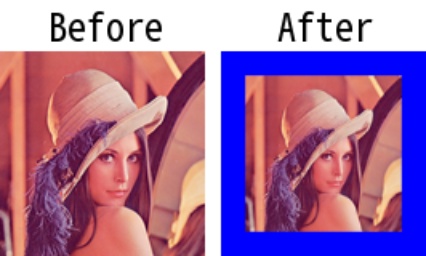pad
-
Description: Perform padding on the input image.
-
Parameters:
- img (
np.ndarray): Input image to be padded. - pad_size (
Union[int, Tuple[int, int], Tuple[int, int, int, int]]): Padding size. It can be an integer to specify the same padding amount for all sides, a tuple(pad_top, pad_bottom, pad_left, pad_right)to specify different padding amounts for each side, or a tuple(pad_height, pad_width)to specify the same padding amount for height and width. - fill_value (
Optional[Union[int, Tuple[int, int, int]]]): Value used for padding. If the input image is a color image (3 channels), fill_value can be an integer or a tuple(R, G, B)to specify the filling color. If the input image is a grayscale image (1 channel), fill_value should be an integer. Default is 0. - pad_mode (
Union[str, int, BORDER]): Padding mode. Available options are:- BORDER.CONSTANT: Pad with constant values (fill_value).
- BORDER.REPLICATE: Pad by replicating edge pixels.
- BORDER.REFLECT: Pad by reflecting the image around the edges.
- BORDER.REFLECT101: Pad by reflecting the image around the edges, with a slight adjustment to avoid artificial seams. Default is BORDER.CONSTANT.
- img (
-
Returns:
- np.ndarray: Padded image.
-
Example:
import docsaidkit as D
img = D.imread('lena.png')
pad_img = D.pad(img, pad_size=20, fill_value=(255, 0, 0))
# Resize the padded image to the original size for visualization
pad_img = D.imresize(pad_img, [img.shape[0], img.shape[1]])